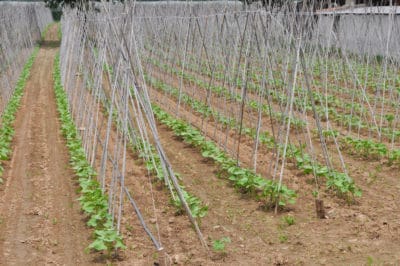Defining the Bean Teepee
In its most simple incarnation, a bean teepee is three or four pieces of wood lashed together at the top. The base of each pole is thrust into the soil at roughly equal distance from the adjoining poles. Bean seeds are planted around the base of the poles and the beans are encouraged to climb the poles. Lima and green beans are often grown on bean teepees instead of a trellis.
Advantages of a Bean Teepee
Bean teepees are typically very inexpensive. Wooden dowels, saplings, bamboo or milling scraps are readily available and provide the necessary strength, as well as an easy surface for the bean vines to twine around. The uprights can be reused, especially if they are removed from the garden and stored under cover during the rainy season.
Choosing Materials
The classic teepee is composed of three poles, but four or more may be used. Each pole should be the same length and about one-and-a-half inches in diameter. The texture of the pole can be rough or smooth. Although any kind of wood can be used, weather-resistant poles of cedar, redwood or cypress may last longer. Twine, heavy string or wire can be used to fasten the poles together.
Beans for a Bean Teepee
Any variety of climbing or pole bean can be grown on a teepee. Potential types or varieties include:
- Blue Lake
- Kentucky Wonder
- Goldmarie Vining
- Asparagus or Yard-Long Bean
- Winged Beans
- Sieva Lima
- King of the Garden Lima
- Christmas Lima
- Runner Beans
- Hyacinth Beans
Planting a Bean Teepee
No special techniques are required to plant a bean teepee. If you plow, till or double dig the soil, do that well in advance. Add amendments to the soil prior to erecting the structure. Aged manure, well-rotted leaves or compost will add humus and nutrients to the soil. Plant four to six beans about one inch deep around each pole.
Permanent Bean Teepees
Treated wooden poles may last longer than untreated wood, but for a permanent teepee, metal is the best option. Steel rebar from a construction project is one option, although rebar is fairly heavy. Aluminum poles are another and lighter possibility. Wrought iron can make a very attractive teepee that will last a lifetime, which can help offset the initial expense.
